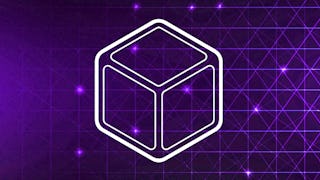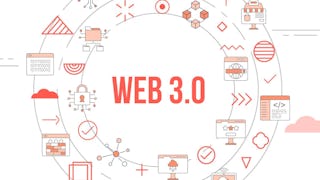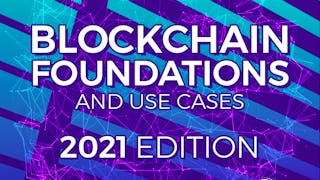There is a lot of hype around Web3 and blockchain. As with any disruptive technology, there are many competing sources of information. But if we look beyond the hype and mania—not to mention the fear, uncertainty, and doubt—we see something profound happening. We are witnessing one of the largest transformations of wealth in human history—from paper-based analog assets to digital ones. Blockchain represents the first native digital medium for value, and is foundational to the next generation of the Internet—also known as Web3.

Gain next-level skills with Coursera Plus for $199 (regularly $399). Save now.

(111 reviews)
What you'll learn
Explain the meaning of terms such as “Web3,” “token,” “smart contract,” “decentralized autonomous organization (DAO),” and “blockchain trilemma”
Describe seven principles for the design of blockchain-based systems, and seven challenge areas associated with implementing blockchain technology
Identify five questions one must consider when deciding whether blockchain is appropriate for a particular problem or use-case
Describe some real-world examples of companies that have integrated blockchain into their business models
Skills you'll gain
Details to know

Add to your LinkedIn profile
5 assignments
See how employees at top companies are mastering in-demand skills

There is 1 module in this course
In this module, you’ll learn what Web3 is, and how it differs from Web1 and Web2 in important ways. You’ll explore blockchain as the foundational technology for the Web3 era, and will learn about key concepts such as digital assets (tokens), smart contracts, decentralized autonomous organizations (DAOs), and the blockchain “trilemma.” By the end of this module, you’ll be able to describe seven blockchain design principles, as well as seven challenge areas associated with implementing blockchain technology. You’ll be able to identify the questions one must consider when determining whether blockchain is appropriate for a particular business problem or use-case. You’ll also be able to describe some real-world examples of companies that have integrated blockchain into their business models.
What's included
11 videos11 readings5 assignments1 discussion prompt1 plugin
Offered by
Explore more from Computer Security and Networks
 Status: Free Trial
Status: Free Trial Status: Free Trial
Status: Free Trial Status: Preview
Status: Preview Status: Preview
Status: PreviewConsenSys Academy
Why people choose Coursera for their career




Learner reviews
111 reviews
- 5 stars
71.17%
- 4 stars
22.52%
- 3 stars
5.40%
- 2 stars
0.90%
- 1 star
0%
Showing 3 of 111
Reviewed on Aug 29, 2024
Holistic overview of Web3 from a business and technical perspective, greatly delivered
Reviewed on Jul 23, 2023
A very good professional and deep overview of Web 3 and the Blockchain.
Reviewed on Apr 25, 2024
Content is really good. Readings stated as 10 mins is not correct. Therefore the course length is certainly more than 3 hours. Otherwise 5 stars,
Frequently asked questions
Web3 is term that represents a collection of technologies, a decentralized network, the ability to digitize assets, and new multi-party business models. Blockchain is the foundation of Web3. On top of that foundation Web3 includes the prediction and decision support of AI, the measurements and actuation of IoT, and the spatial UX of AR/VR/Metaverse.
Previous foundational technologies such as railroads, electrical grids, telecommunication networks, and the internet have all defined eras. They have enabled new ways of conducting business and interacting with governments. Entirely new business and civil society models became possible. They have all been characterized by accelerated economic growth and significant improvements in the efficiency of the means of production. The era enabled by blockchain has been labeled the Web3 era.
The Web3 era will be characterized by smaller economic actors coordinating their activities to generate value with great efficiency. It will feature accelerated rates of innovation, a proliferation of new business models and configurations, and new ways of delivering public services.
A common authoritative record of transactions, and the data that describes those transactions, is fundamental to all business interactions. Traditionally the data, and the state of the data, has been maintained in databases and ledgers controlled by companies or governments who rely on auditors, trusted third parties and the legal enforceability of contracts to support confidence in transactional interactions and the related business velocity.
Blockchain makes data, transaction records, and the business logic that can manipulate the data a fundamental characteristic of a decentralized network. This is a revolutionary capability.
Blockchain is the foundational technology for the Web3 era. It is the database and operating system of the networked economy. As the world’s businesses and governments continue to digitize, their systems will run on blockchain.
To access the course materials, assignments and to earn a Certificate, you will need to purchase the Certificate experience when you enroll in a course. You can try a Free Trial instead, or apply for Financial Aid. The course may offer 'Full Course, No Certificate' instead. This option lets you see all course materials, submit required assessments, and get a final grade. This also means that you will not be able to purchase a Certificate experience.
More questions
Financial aid available,








